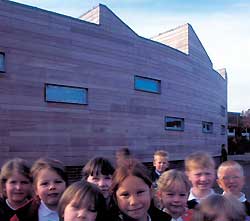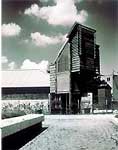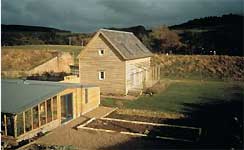Timber cladding in Scotland
The study outlines the development of timber cladding in Scotland, describes timber clad buildings in Scotland, and provides practical information on the use of timber cladding in Scotland.
Timber Cladding in Scotland

|
INTRODUCTIONThere is no easy explanation why timber-cladding has not been widely used in Scotland. There are suggestions that there are special climatic factors; a combination of wind and rain, that suitable indigenous wood could not be obtained at a competitive price, that there are not the skilled workers to carry out the work, that building societies are unenthusiastic about the technique and insurance companies are also reluctant to cover its use. The evidence is anecdotal and some of it can be easily discounted… (1) External cladding is the outermost envelope of a building and normally carries no loading beyond its own weight plus those loads imposed by rain, snow and wind. It is thus mainly a protective and decorative envelope for the structure and contents of a building, and can be constructed from a variety of different materials including metal sheets, pre-cast concrete slabs, uPVC, tiles, masonry, and timber. In principle, each is interchangeable in terms of its cladding function, allowing several different cladding materials to be used side by side on the same building. |
Shaped and profiled iroko boarding to Hawthornden School, Bonnyrigg, by Ungless and Latimer Architects. |
Most people in Scotland today are unfamiliar with external timber cladding, a fact compounded by the lack of published research on the historical use of timber in Scottish construction. Yet there are strong historical precedents throughout our urban and rural environments for the use of external timber cladding - it was an important exterior wall covering in medieval Scotland's royal burghs, for example, and continued to be used in urban Scotland until the 17th century. During the 18th and 19th centuries timber cladding was still used on a wide range of non-domestic buildings as well as occasionally on housing, particularly in remote rural areas. During the 20th century, timber cladding was extensively utilised on social housing and, over the past five years, a small but significant growth in the use of external timber cladding in Scotland has been evident. Providing it is designed for durability, it can achieve a performance comparable to that of timber cladding in similar maritime climates abroad (e.g. western Norway or Canada) where its use is widespread. And yet, perhaps because of uncertainties and information gaps, many people - including some planning authorities - remain reluctant to recognise timber cladding as either a traditional wall finish or as a cladding material for Scotland's wet, windy climate.
The historical material contained here is only a preliminary review of the evidence of external timber cladding in Scotland and is necessarily wide in range and containing many uncertainties. The authors hope archaeologists and architectural historians will be encouraged to carry out further work on the subject.
Being the area where most difficulties arise, the technical sections of this publication focus on the management of moisture due to wind-driven rain. Other issues (e.g. fire) are not dealt with in any depth since, although impacting upon the design of timber cladding, they are already well understood and fully incorporated within the Scottish Building Regulations. Current best practice in the specification and detailing of timber cladding is also reviewed, and is based upon a comparison of current practice in the exposed coastal climates of British Columbia, western Norway and Scotland. The scope of the technical parts of this publication is limited to the cladding of low-rise buildings in Scotland and not all of the issues raised are necessarily relevant to taller buildings or to the requirements of the Building Regulations in England and Wales. Moreover, some of the points discussed are an interpretation of the Scottish regulations and other interpretations are possible.
Sustainability is a key factor driving current interest in timber cladding in Scotland. Consequently a distinction has been sought between standard practices which - while widely accepted and well proven - do not always minimise the use of wood preservatives or high energy consumption, and those other practices which not only comply with the regulatory framework but also aim to minimise the use of preservatives and promote better energy use.
Recent growth of interest in external timber cladding has brought all of these issues to the fore, and the Scottish Executive recognises that further development may be constrained by a lack of accurate information specific to Scottish needs. This publication therefore aims to provide accurate and up-to-date guidance for architects, self-builders, planning and building control officers, contractors and cladding manufacturers. By describing, illustrating and interpreting its historical and contemporary design, it is hoped to stimulate further discussion on the future potential of timber cladding in Scotland.
|
|
Timber cladding, slats and shingles are collaged
|
Timber cladding adds to the simple elegance of
|
THE BENEFITS OF EXTERNAL TIMBER CLADDING
Timber cladding can offer a unique combination of benefits of value to both urban and rural Scotland:
- Improved energy efficiency
Timber framed, timber-clad houses can deliver real energy cost savings combined with good performance. When lightweight external claddings (e.g. timber) are used, heavy and bulky masonry walls can be eliminated from the outside of the building. Lightweight cladding, when combined with lightweight roof coverings and lightweight wall structures, can produce significant weight savings, allowing foundation depths and widths in a typical house to be reduced, with up to 20-40% savings in below-ground costs (2,3). Money saved can be used to increase the building's insulation so that, for no additional cost relative to masonry cladding, a more energy-efficient building envelope can be created. On the principle that building construction should not include costs that do not add consumer value, this potential combination is compelling. - Promotion of good design and siting
Timber cladding complements current thinking on rural housing design. Market forces in rural Scotland are already delivering keenly priced, flexible and quick-to-erect housing and timber cladding offers considerable advantages in this context: it can reduce costs, introduce colour and - because it is relatively easy to modify - is suited to the kind of long-life, loose-fit approach currently advocated through the 'lifetime homes' approach to housing design. - Encouraging originality and innovation
Timber cladding can have a bright and vibrant finish or, alternatively, a natural appearance which complements many other materials. It offers considerable design flexibility, and is easily adapted to both traditional and contemporary styles of building. - Overcoming the disadvantages of remoteness e.g. high building costs
Timber cladding's light weight offers lower transport costs than masonry cladding and is not so weather-dependent to erect, both of which are considerable benefits in remote rural areas. - Stimulating the prudent use of natural resources
Timber is a renewable and environmentally friendly raw material, and UK woodland management standards are comparable to those of most other western European countries. Providing the felling operation has official approval, home-grown or European timber is generally accepted as a low environmental impact raw material in terms of its production and compares favourably with non-renewable raw materials such as stone, metals or plastics. - Supporting local economic development
Customers will favour environmentally sound or locally sourced products providing their price and quality match existing alternatives. Although there may not always be a cost premium available, there is a potential market share advantage for those environmentally-sound or more locally-based suppliers able to capitalise on it. Timber cladding is manufactured in Scotland and, as the market expands, local economic opportunities can grow. - Increasing the use of local raw materials
Historically, the majority of timber cladding used in Scotland was imported and this continues to be so today. There is growing interest in buying locally manufactured products, thereby minimising energy consumed in transportation whilst contributing to the local economy and culture. European larch cladding is particularly popular and can be sourced in Scotland, as can European oak and some other timbers (European Larch is the trade name for the species Larix decidua and European oak is the trade name for the species Quercus robur and Q. petraea).
References
1 Scottish Office, 1988, Designing for Quality.
2 TRADA Technology, 2001, Timber frame construction.
3 Deveci, G., et al. Undated, Towards Zero-heating,Unpublished.
Contact
Email: Central Enquiries Unit ceu@gov.scot
There is a problem
Thanks for your feedback

